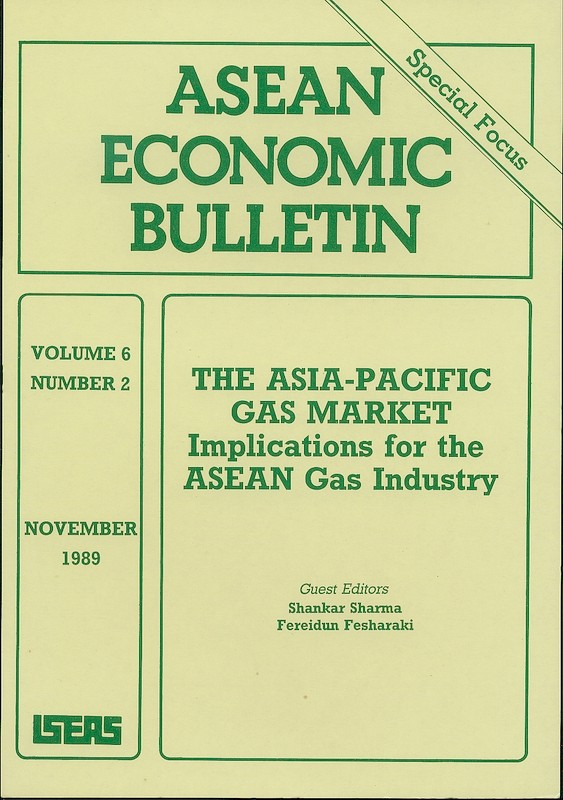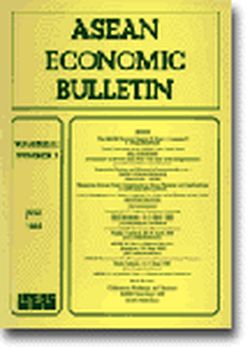ASEAN Economic Bulletin Vol. 7/1 (Jul 1990)

Date of publication:
July 1990
Number of pages:
154
Code:
AE7/1
Contents
-
Preliminary pages
- ARTICLES
-
ANZCERTA, Trade in Services, and ASEAN, by Frank Holmes, author see abstractThe article briefly traces the history of the breaking down of barriers to trade in goods between Australia and New Zealand, and draws some conclusions from this experience on factors conducive to liberalization of trade in services. The protocol extending the Closer Economic Relations (CER) agreement to services is discussed, as is the New Zealand proposal for the incorporation of services in GATT in a manner likely to lead to progressive liberalization. The implications for ASEAN and other developing countries are considered.
-
Voluntary Debt Relief and the Philippines, by Michael Bowe, James W Dean, authors see abstractThis article outlines the rationale for debt relief in general and demonstrates the potential for market-based debt conversion. It then examines the history of and potential for a debt conversion programme in the Philippines.
-
Capital Structure Differences among Large Asian Companies, by Raj Aggarwal, author see abstractThis article reviews prior research regarding influences on capital structure and reports the results of an empirical study of the capital structures of large Asian companies. Variations with regard to the country, industry, and size of a company are examined for the first time for a sample as large as four hundred and seventy-four companies located in twenty Asian countries. The results of this study indicate that while size does not seem to be a significant influence, both country and industry are significant factors influencing capital structure in Asia. Multinational and diversified companies, therefore, must take these differences into account in developing and setting capital structure, financing, subsidiary evaluation, and management policies for their Asian operations. Bankers, other creditors, and investors also must recognize national differences in debt ratios in order to assess credit and investment risks accurately.
-
Measuring Capital Flight: A Time Varying Regression Analysis with Special Reference to the Philippines and India, by Benu Varman-Schneider, Wolfgang Schneider, authors see abstractThis article discusses two particular approaches to measuring capital flight. Varman (1989) tried to determine the normal component of gross capital outflows (explained by transaction balances of firms abroad) and measure capital flight as a residual explained by a particular event structure which caused capital flight. The event structure takes the form of a prior setup of dummy variables; capital flight is then estimated under this maintained hypothesis. Two case studies, India and the Philippines, illustrate this procedure. In this paper, using the same data set, the assumption of a given specification of flight inducing event patterns is relaxed and a data analytical technique known as flexible least squares is used to identify the years where capital flight presumably took place. Problems with this technique arise at the time of a shifting regression relationship when several events operate, in which case an a priori specification of several dummies to separate the effects is needed.
-
A Comparative Analysis of Managerial Practices among SMEs from Malaysia, Singapore, and Thailand, by Jack Dart, Ignace Ng, Asit Sarkar, authors see abstractThe primary purpose of this article is to compare and contrast the managerial practices and problems faced by the SMEs operating in Malaysia, Singapore, and Thailand. While such a comparative analysis has been done in the past, this study differs from previous studies in two ways. First, the same questionnaire is used across the three countries thus allowing for more consistent comparison. Second, this study is the first to examine human resource management problems and practices.
-
Future Patterns of Electricity Development in Japan: Implications for ASEAN Hydrocarbon Exports, by Hisashi Amagai, Shankar Sharma (A), authors see abstractThis study presents estimates of Japans future power generation mix under four different policy scenarios. These four scenarios include: (1) the Ministry of International Trade and Industry's (MITI) plan; (2) a programme of sulfur dioxide and nitrogen oxide emissions abatement; (3) a moratorium on construction of new nuclear power plants; and (4) a combination of emissions abatement and constrained nuclear power generation. A multi-objective programming model was utilized to derive future energy requirements for the power sector. The analysis shows that the impact of different plans for power generation in Japan will be minimal on ASEAN-Japan oil trade, but the liquefied natural gas (LNG) imports from ASEAN may increase significantly under the emissions abatement and/or constrained nuclear power scenarios. If all the additional LNG required are imported from ASEAN, the regions export may rise by up to 24 per cent.
-
Industrial Development, the New Economic Policy in Malaysia, and the International Division of Labour, by Wong Tai Chee, author see abstractThe redistributive approach of the New Economic Policy in Malaysia has influenced the manufacturing structure of the country. On the one hand, the government used heavy industry and large enterprises to accelerate the advance of the Malays in modern commerce and industry, the predominantly Chinese-owned small and medium scale industry made little progress, and consequently missed gaining a share in international markets for lack of political support. Conversely, multinational capital, focused on electronics, has been used to boost national growth and offset the mostly non-lucrative public enterprises. Since 1986, however, the Malaysian Government has taken some measures to gradually readjust the distortions. This article studies how state-owned heavy industry, local small industry and the technologically superior multinational capital interact to give rise to Malaysia's present industrial structure.
-
DOCUMENTATION: Joint Statement of the Asia Pacific Economic Cooperation Ministerial Meeting, Singapore, 31 July 1990
-
DOCUMENTATION: Excerpts from the Joint Communiqu of the 23rd ASEAN Ministerial Meeting, Jakarta, 24-25 July 1990
-
BOOK REVIEW: European Currency in the Making, edited by Otmar Franz
-
BOOK REVIEW: European Community Trade Barriers to Tropical Agricultural Products, by Michael Davenport, by Dermot McAleese, author
-
BOOK REVIEW: Financial Liberalization and Economic Development: A Reassessment of Interest-Rate Policies in Asia and Latin America, by Ronald I McKinnon, by James W Dean, author
-
BOOK REVIEW: The Population of Peninsular Malaysia, by Saw Swee Hock, by Warwick Neville, author
-
BOOK REVIEW: The World Competitiveness Report 1989., by Joseph L H Tan, author
-
Conferences, Workshops and Seminars
-
ASEAN Chronology 1990
-
Some Recent Publications





